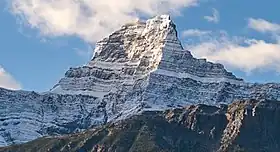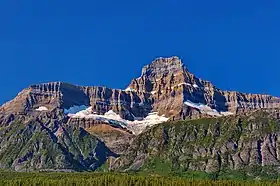| Mount Christie | |
|---|---|
 Mount Christie centered above the Icefields Parkway with Brussels Peak to its right and Mount Lowell furthest to right | |
| Highest point | |
| Elevation | 3,103 m (10,180 ft)[1] |
| Prominence | 303 m (994 ft)[1] |
| Parent peak | Brussels Peak (3,161 m)[1] |
| Listing | Mountains of Alberta |
| Coordinates | 52°31′52″N 117°48′39″W / 52.53111°N 117.81083°W[2] |
| Geography | |
 Mount Christie Location of Mount Christie in Alberta  Mount Christie Mount Christie (Canada) | |
| Location | Alberta, Canada |
| Parent range | Canadian Rockies |
| Topo map | NTS 83C12 Athabasca Falls[2] |
| Geology | |
| Type of rock | Sedimentary |
| Climbing | |
| First ascent | 1930 by W.R. Hainsworth, J.F. Lehmann, M.M. Strumia, N.D. Waffl[3] |
Mount Christie is a 3,103-metre (10,180 ft) mountain summit located in the Athabasca River valley of Jasper National Park, in the Canadian Rockies of Alberta, Canada. The nearest higher peak is Brussels Peak, 1.67 km (1.04 mi) to the south-southwest.[4] Mount Christie can be seen from the Icefields Parkway.
History
The mountain was named by James Hector in 1859 for William J. Christie, a Canadian explorer and politician.[5] Christie was the Chief factor at the Hudson's Bay Company in Fort Edmonton when Hector and the Palliser expedition wintered there in 1858–1859.[3] The first ascent of the mountain was made in 1930 by W.R. Hainsworth, J.F. Lehmann, M.M. Strumia, and N.D. Waffl. The mountain's name was officially adopted as Mount Christie in 1947 by the Geographical Names Board of Canada.[2]
Geology
Mount Christie is composed of sedimentary rock laid down from the Precambrian to Jurassic periods.[6] Formed in shallow seas, this sedimentary rock was pushed east and over the top of younger rock during the Laramide orogeny.[7]
Climate

Based on the Köppen climate classification, Mount Christie is located in a subarctic climate zone with cold, snowy winters, and mild summers.[8] Winter temperatures can drop below -20 °C with wind chill factors below -30 °C. Precipitation runoff from Mount Christie drains into the Athabasca River.
See also

References
- 1 2 3 "Mount Christie". Bivouac.com. Retrieved 2018-10-18.
- 1 2 3 "Mount Christie". Geographical Names Data Base. Natural Resources Canada. Retrieved 2018-10-18.
- 1 2 "Mount Christie". cdnrockiesdatabases.ca. Retrieved 2019-09-16.
- ↑ "Mount Christie, Alberta". Peakbagger.com. Retrieved 2019-09-16.
- ↑ Place-names of Alberta. Ottawa: Geographic Board of Canada. 1928. p. 34.
- ↑ Belyea, Helen R. (1960). The Story of the Mountains in Banff National Park (PDF). parkscanadahistory.com (Report). Ottawa: Geological Survey of Canada. Archived (PDF) from the original on 2015-10-02. Retrieved 2019-09-13.
- ↑ Gadd, Ben (2008). Geology of the Rocky Mountains and Columbias.
- ↑ Peel, M. C.; Finlayson, B. L.; McMahon, T. A. (2007). "Updated world map of the Köppen−Geiger climate classification". Hydrol. Earth Syst. Sci. 11: 1633–1644. ISSN 1027-5606.
External links
- Parks Canada web site: Jasper National Park